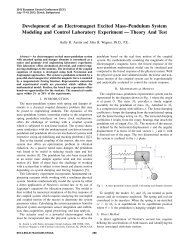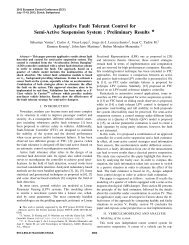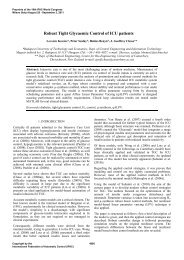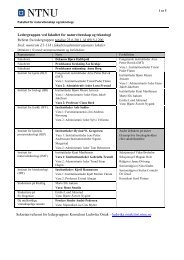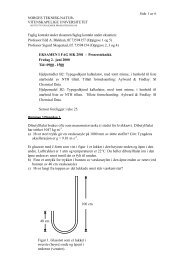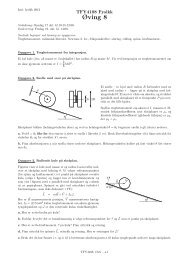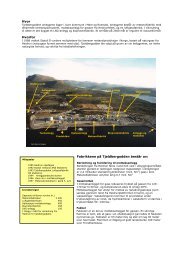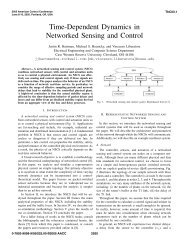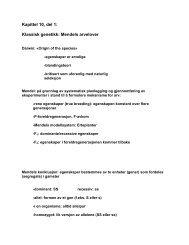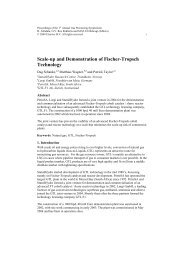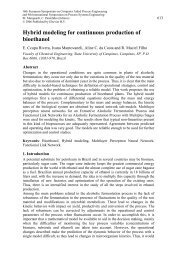- Page 1 and 2: AIChE Symposium Series No. 326 Volu
- Page 3 and 4: Preface The sixth International Che
- Page 5 and 6: Contents INVITED PAPERS Opening Ses
- Page 7: Feedback Control of Stable, Non-min
- Page 11 and 12: Business Process Control: The Outer
- Page 13 and 14: Business Process Control: The Outer
- Page 15 and 16: Influence of Computers and Informat
- Page 17 and 18: Influence of Computers and Informat
- Page 19 and 20: Influence of Computers and Informat
- Page 21 and 22: Nonlinear Model Reduction for Optim
- Page 23 and 24: Nonlinear Model Reduction for Optim
- Page 25 and 26: Nonlinear Model Reduction for Optim
- Page 27 and 28: Nonlinear Model Reduction for Optim
- Page 29 and 30: Nonlinear Model Reduction for Optim
- Page 31 and 32: Nonlinear Model Reduction for Optim
- Page 33 and 34: Nonlinear Model Reduction for Optim
- Page 35 and 36: Nonlinear Model Reduction for Optim
- Page 37 and 38: Nonlinear Model Reduction for Optim
- Page 39 and 40: Nonlinear Model Reduction for Optim
- Page 41 and 42: Nonlinear Model Reduction for Optim
- Page 43 and 44: Nonlinear Model Reduction for Optim
- Page 45 and 46: Nonlinear Model Reduction for Optim
- Page 47 and 48: Nonlinear Model Reduction for Optim
- Page 49 and 50: Nonlinear Model Reduction for Optim
- Page 51 and 52: Model Requirements for Next Generat
- Page 53 and 54: Model Requirements for Next Generat
- Page 55 and 56: Model Requirements for Next Generat
- Page 57 and 58: Model Requirements for Next Generat
- Page 59 and 60:
Model Requirements for Next Generat
- Page 61 and 62:
Model Requirements for Next Generat
- Page 63 and 64:
Recent Advances and Challenges in P
- Page 65 and 66:
Recent Advances and Challenges in P
- Page 67 and 68:
Recent Advances and Challenges in P
- Page 69 and 70:
Recent Advances and Challenges in P
- Page 71 and 72:
Recent Advances and Challenges in P
- Page 73 and 74:
Recent Advances and Challenges in P
- Page 75 and 76:
Recent Advances and Challenges in P
- Page 77 and 78:
Recent Advances and Challenges in P
- Page 79 and 80:
Recent Advances and Challenges in P
- Page 81 and 82:
Recent Advances and Challenges in P
- Page 83 and 84:
Keywords Controlled Biological Proc
- Page 85 and 86:
Controlled Biological Processes and
- Page 87 and 88:
Controlled Biological Processes and
- Page 89 and 90:
Stochastic and Deterministic Contro
- Page 91 and 92:
Computer-Aided Design of Metabolic
- Page 93 and 94:
Computer-Aided Design of Metabolic
- Page 95 and 96:
Computer-Aided Design of Metabolic
- Page 97 and 98:
Computer-Aided Design of Metabolic
- Page 99 and 100:
Computer-Aided Design of Metabolic
- Page 101 and 102:
Neuro-Dynamic Programming: An Overv
- Page 103 and 104:
Neuro-Dynamic Programming: An Overv
- Page 105 and 106:
The Behavioral Approach to Modeling
- Page 107 and 108:
The Behavioral Approach to Modeling
- Page 109 and 110:
The Behavioral Approach to Modeling
- Page 111 and 112:
The Behavioral Approach to Modeling
- Page 113 and 114:
The Behavioral Approach to Modeling
- Page 115 and 116:
The Behavioral Approach to Modeling
- Page 117 and 118:
Abstract Input to State Stability a
- Page 119 and 120:
Input to State Stability and Relate
- Page 121 and 122:
Input to State Stability and Relate
- Page 123 and 124:
Input to State Stability and Relate
- Page 125 and 126:
Input to State Stability and Relate
- Page 127 and 128:
Input to State Stability and Relate
- Page 129 and 130:
Hybrid Systems in Process Control:
- Page 131 and 132:
Hybrid Systems in Process Control:
- Page 133 and 134:
Hybrid Systems in Process Control:
- Page 135 and 136:
Hybrid Systems in Process Control:
- Page 137 and 138:
Hybrid Systems in Process Control:
- Page 139 and 140:
Hybrid Systems in Process Control:
- Page 141 and 142:
Hybrid Systems in Process Control:
- Page 143 and 144:
Hybrid Systems in Process Control:
- Page 145 and 146:
Hybrid System Analysis and Control
- Page 147 and 148:
Hybrid System Analysis and Control
- Page 149 and 150:
Hybrid System Analysis and Control
- Page 151 and 152:
Hybrid System Analysis and Control
- Page 153 and 154:
Hybrid System Analysis and Control
- Page 155 and 156:
Hybrid System Analysis and Control
- Page 157 and 158:
Hybrid System Analysis and Control
- Page 159 and 160:
Discrete Optimization Methods and t
- Page 161 and 162:
Discrete Optimization Methods and t
- Page 163 and 164:
Discrete Optimization Methods and t
- Page 165 and 166:
Discrete Optimization Methods and t
- Page 167 and 168:
Discrete Optimization Methods and t
- Page 169 and 170:
Discrete Optimization Methods and t
- Page 171 and 172:
Discrete Optimization Methods and t
- Page 173 and 174:
Discrete Optimization Methods and t
- Page 175 and 176:
Discrete Optimization Methods and t
- Page 177 and 178:
Increasing Customer Value of Indust
- Page 179 and 180:
Increasing Customer Value of Indust
- Page 181 and 182:
Increasing Customer Value of Indust
- Page 183 and 184:
Increasing Customer Value of Indust
- Page 185 and 186:
Increasing Customer Value of Indust
- Page 187 and 188:
Increasing Customer Value of Indust
- Page 189 and 190:
Increasing Customer Value of Indust
- Page 191 and 192:
Increasing Customer Value of Indust
- Page 193 and 194:
Increasing Customer Value of Indust
- Page 195 and 196:
Increasing Customer Value of Indust
- Page 197 and 198:
Increasing Customer Value of Indust
- Page 199 and 200:
Multivariate Controller Performance
- Page 201 and 202:
Multivariate Controller Performance
- Page 203 and 204:
Multivariate Controller Performance
- Page 205 and 206:
Multivariate Controller Performance
- Page 207 and 208:
Multivariate Controller Performance
- Page 209 and 210:
Multivariate Controller Performance
- Page 211 and 212:
Multivariate Controller Performance
- Page 213 and 214:
Multivariate Controller Performance
- Page 215 and 216:
Multivariate Controller Performance
- Page 217 and 218:
Recent Developments in Controller P
- Page 219 and 220:
Recent Developments in Controller P
- Page 221 and 222:
Recent Developments in Controller P
- Page 223 and 224:
Recent Developments in Controller P
- Page 225 and 226:
Recent Developments in Controller P
- Page 227 and 228:
Recent Developments in Controller P
- Page 229 and 230:
Recent Developments in Controller P
- Page 231 and 232:
Simultaneous Design and Control Opt
- Page 233 and 234:
Simultaneous Design and Control Opt
- Page 235 and 236:
Simultaneous Design and Control Opt
- Page 237 and 238:
Simultaneous Design and Control Opt
- Page 239 and 240:
Simultaneous Design and Control Opt
- Page 241 and 242:
Simultaneous Design and Control Opt
- Page 243 and 244:
Simultaneous Design and Control Opt
- Page 245 and 246:
Simultaneous Design and Control Opt
- Page 247 and 248:
Optimal Operation and Control of Si
- Page 249 and 250:
Optimal Operation and Control of Si
- Page 251 and 252:
Optimal Operation and Control of Si
- Page 253 and 254:
Optimal Operation and Control of Si
- Page 255 and 256:
Optimal Operation and Control of Si
- Page 257 and 258:
Optimal Operation and Control of Si
- Page 259 and 260:
Optimal Operation and Control of Si
- Page 261 and 262:
Optimal Operation and Control of Si
- Page 263 and 264:
Dynamic Optimization in the Batch C
- Page 265 and 266:
Dynamic Optimization in the Batch C
- Page 267 and 268:
Dynamic Optimization in the Batch C
- Page 269 and 270:
Dynamic Optimization in the Batch C
- Page 271 and 272:
Dynamic Optimization in the Batch C
- Page 273 and 274:
Dynamic Optimization in the Batch C
- Page 275 and 276:
Dynamic Optimization in the Batch C
- Page 277 and 278:
Dynamic Optimization in the Batch C
- Page 279 and 280:
Dynamic Optimization in the Batch C
- Page 281 and 282:
Dynamic Optimization in the Batch C
- Page 283 and 284:
Dynamics and Control of Cell Popula
- Page 285 and 286:
Dynamics and Control of Cell Popula
- Page 287 and 288:
Dynamics and Control of Cell Popula
- Page 289 and 290:
Dynamics and Control of Cell Popula
- Page 291 and 292:
Dynamics and Control of Cell Popula
- Page 293 and 294:
Dynamics and Control of Cell Popula
- Page 295 and 296:
Dynamics and Control of Cell Popula
- Page 297 and 298:
Dynamics and Control of Cell Popula
- Page 299 and 300:
Control of Product Quality in Polym
- Page 301 and 302:
Control of Product Quality in Polym
- Page 303 and 304:
Control of Product Quality in Polym
- Page 305 and 306:
Control of Product Quality in Polym
- Page 307 and 308:
Control of Product Quality in Polym
- Page 309 and 310:
Control of Product Quality in Polym
- Page 311 and 312:
Control of Product Quality in Polym
- Page 313 and 314:
Control of Product Quality in Polym
- Page 315 and 316:
Particle Size and Shape Control in
- Page 317 and 318:
Particle Size and Shape Control in
- Page 319 and 320:
Particle Size and Shape Control in
- Page 321 and 322:
Particle Size and Shape Control in
- Page 323 and 324:
Particle Size and Shape Control in
- Page 325 and 326:
Particle Size and Shape Control in
- Page 327 and 328:
Particle Size and Shape Control in
- Page 329 and 330:
Particle Size and Shape Control in
- Page 331 and 332:
Particle Size and Shape Control in
- Page 333 and 334:
Particle Size and Shape Control in
- Page 335 and 336:
Particle Size and Shape Control in
- Page 337 and 338:
Linking Control Strategy Design and
- Page 339 and 340:
Linking Control Strategy Design and
- Page 341 and 342:
Linking Control Strategy Design and
- Page 343 and 344:
Linking Control Strategy Design and
- Page 345 and 346:
Linking Control Strategy Design and
- Page 347 and 348:
Linking Control Strategy Design and
- Page 349 and 350:
Linking Control Strategy Design and
- Page 351 and 352:
Evolution of an Industrial Nonlinea
- Page 353 and 354:
Evolution of an Industrial Nonlinea
- Page 355 and 356:
Evolution of an Industrial Nonlinea
- Page 357 and 358:
Evolution of an Industrial Nonlinea
- Page 359 and 360:
Evolution of an Industrial Nonlinea
- Page 361 and 362:
Emerging Technologies for Enterpris
- Page 363 and 364:
Emerging Technologies for Enterpris
- Page 365 and 366:
Emerging Technologies for Enterpris
- Page 367 and 368:
Emerging Technologies for Enterpris
- Page 369 and 370:
Emerging Technologies for Enterpris
- Page 371 and 372:
Emerging Technologies for Enterpris
- Page 373 and 374:
A Definition for Plantwide Controll
- Page 375 and 376:
A Definition for Plantwide Controll
- Page 377 and 378:
Nonlinear Process Control: Novel Co
- Page 379 and 380:
Nonlinear Process Control: Controll
- Page 381 and 382:
Nonlinear Process Control: Controll
- Page 383 and 384:
Efficient Nonlinear Model Predictiv
- Page 385 and 386:
Efficient Nonlinear Model Predictiv
- Page 387 and 388:
Controller Design for Ventricular A
- Page 389 and 390:
Controller Design for Ventricular A
- Page 391 and 392:
Controller Design for Ventricular A
- Page 393 and 394:
Assessment of Performance for Singl
- Page 395 and 396:
Assessment of Performance for Singl
- Page 397 and 398:
Feedback Control of Stable, Non-min
- Page 399 and 400:
Feedback Control of Stable, Non-min
- Page 401 and 402:
Self-optimizing Control of a Large-
- Page 403 and 404:
Self-optimizing Control of a Large-
- Page 405 and 406:
Self-optimizing Control of a Large-
- Page 407 and 408:
Robust Passivity Analysis and Desig
- Page 409 and 410:
Robust Passivity Analysis and Desig
- Page 411 and 412:
On-line Optimization of a Crude Uni
- Page 413 and 414:
On-line Optimization of a Crude Uni
- Page 415 and 416:
On-line Optimization of a Crude Uni
- Page 417 and 418:
Process Control Benefit Estimation
- Page 419 and 420:
Process Control Benefit Estimation
- Page 421 and 422:
Abstract Connection between Model P
- Page 423 and 424:
Connection between Model Predictive
- Page 425 and 426:
Connection between Model Predictive
- Page 427 and 428:
Efficient Nonlinear Model Predictiv
- Page 429 and 430:
Efficient Nonlinear Model Predictiv
- Page 431 and 432:
Partial Differential Equation Model
- Page 433 and 434:
Partial Differential Equation Model
- Page 435 and 436:
Partial Differential Equation Model
- Page 437 and 438:
Steady State Multiplicity and Stabi
- Page 439 and 440:
Steady State Multiplicity and Stabi
- Page 441 and 442:
Feasible Real-time Nonlinear Model
- Page 443 and 444:
Feasible Real-time Nonlinear Model
- Page 445 and 446:
Feasible Real-time Nonlinear Model
- Page 447 and 448:
Industrial Experience with State-Sp
- Page 449 and 450:
Industrial Experience with State-Sp
- Page 451 and 452:
A Computationally Efficient Formula
- Page 453 and 454:
A Computationally Efficient Formula
- Page 455 and 456:
A Computationally Efficient Formula
- Page 457 and 458:
Time Series Reconstruction from Qua
- Page 459 and 460:
Time Series Reconstruction from Qua
- Page 461 and 462:
Author Index A Allgöwer, Frank, 37
- Page 463 and 464:
Subject Index A Adaptive agents, 35



